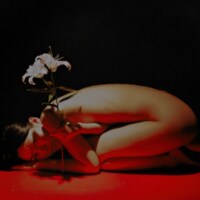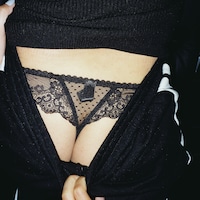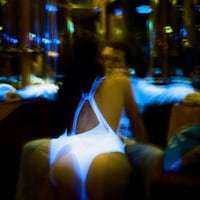The artist’s new exhibition, Nowt As Queer As Folk, examines our disenchantment with modern life and the reality of growing up in a rural community
Corbin Shaw is an iconoclast afflicted with nostalgia. His work unites deeply reverential feelings towards the past with a radical desire to dismantle anything that no longer functions and create something brand new. Whether it’s examining the performance and expectations of masculinity and the pressure to “fit into a lad-shaped box”, or celebrating the coronation by tucking into a “full English” outside Buckingham Palace, Shaw may invoke the iconographies of inherited traditions but he doesn’t uphold them.
In his latest exhibition, Nowt As Queer As Folk (at London’s Guts Gallery) Shaw revisits his roots in rural South Yorkshire. Through a series of tapestries, sculptural works, and the recreation of a traditional ‘well dressing’, he excavates the mythology of village life, entrenched in customs, folklore, and misunderstandings. “The show is situated around my years spent living in my hometown of Harthill, South Yorkshire. It’s about how we relate to the land that birthed us and the traditions and ceremonies that are embedded in it,” he tells Dazed. I’m using folk traditions and their visual language to talk about British village life and the struggles of growing up in one. I don’t want to perpetuate the myth that folk has created of this fantasy village life. I want to commemorate and talk about Britain now, and create new traditions and ceremonies where we critique and celebrate Britain, a new Britain.”
The obscure custom of well dressing – sometimes referred to as “well flowering” – involves honouring the village well by decorating it with petals, and it’s distinctly local to Shaw’s native part of England. Its origins are mysterious but some believe it to be a pagan ritual, while other theories connect it with a celebration of pure water in the aftermath of the bubonic plague in the mid-1300s. For Shaw, well dressing functions as a way to discuss the slippage between bucolic ideals of pastoral life and the reality of growing up in a contemporary village in the north of England.
“Modern-day village life has become a far cry from the idolised, picturesque, folkish depictions. Its green rolling hills, historic towns, and rich culture is not a reality that is representative of everyday English people and how they live,” Shaw explains. “Young people in rural communities are often marginalised, with fewer opportunities for jobs, public transport, and poor education. Village life is a far cry from how people from cities imagine it to be.”
Nowt As Queer As Folk complicates the idyllic, quaint idea of villages with the harsh reality of disenfranchised youth, lack of opportunities, and the crushing pressure of convention, all narrated through the traditional and regional crafts historically associated with the broken ideology he’s sifting through the remnants of. “I’ve emphasised this lost enchantment with village life through weaving and stitching phrases and slang from contemporary village culture onto tapestries, banners, and on the well as emblems and a passage from old village life to the modern here and now,” Shaw explains. “History offers depictions of a country melancholic about the loss of Empire, power-hungry, and secretive about its true agendas hiding behind flowers and folk dance. We witnessed in our current climate the roots of Brexit that hold onto that mythical, nostalgic idea of England that was invented in those years.
Below, we talk to Corbin Shaw about Nowt As Queer As Folk, performing regional and gender identities, and creating new ceremonies as opposed to perpetuating harmful traditions.
![Corbin Shaw, Nowt As Queer As Folk [2022]](https://images-prod.dazeddigital.com/786/azure/dazed-prod/1310/9/1319714.jpg)
What’s ‘well dressing’ and what appealed to you about this tradition?
Corbin Shaw: ‘The village is calling to me, I’m longing for the land that I refused for so long’ is something from my iPhone notes. I was inspired by the purity of giving thanks to the land and the seasons. I wanted to give thanks and comment on the village I grew up in. I wanted to talk about the rituals and ceremonies me and my friends had as adolescent teens knocking about in the sticks.
What does well-dressing mean to you and how have you used it as a metaphor?
Corbin Shaw: My well is a shrine to my family. The well is about giving thanks to the clean water that flows through the valleys. The well is talking about both the history and the modern-day Harthill, commemorating the characters that live in the village, the everyday people and their lives.
My well is a study for a well dressing that I will dress in my village back home. There’ll be a procession with my banners that starts at the village hall and we walk all the banners to the well and bless the well. All my work is a love letter to my family and my home, really.
![Corbin Shaw, Nowt As Queer As Folk [2022]](https://images-prod.dazeddigital.com/640/azure/dazed-prod/1310/9/1319820.jpg)
How do you think our relationship with place, tradition, and history has changed over the generations? And in what ways are we better and worse off?
Corbin Shaw: I don’t feel that folk is inherently bad, if traditions and ceremonies are being held and practised which aren’t harmful I think that’s fine. But I think in my thinking I would like to introduce new ceremonies in which we draw on the real past of Britain and the contemporary history of our areas like or grease pit in Sheffield near where I grew up. I think it is important to create ceremonies and celebrate modern England as it is today in the people that came here and built it and give thanks to those people and everyone who inhabits it
Much of your work explores expectations of masculinity. How does the exhibition comment on gender and manhood?
Corbin Shaw: The work in this exhibition talks about that mid-teen crisis, the coming-of-age and the confusion, the trappings of village life and the prescribed life of ‘get a job, get a car, get married, get a mortgage’. One of the works in the show titled ‘village dreams die hard’ is a poem I wrote that sums up my personal experience of nearly dropping out of school to work with my Dad and going to awful clubs in town on the weekend. I was very identity-confused at this time. I was constantly trying to fit into a lad-shaped box.
Along with other artists such as Mitch Vowles, Sam Nowell, and Celeste McEvoy, it feels like you’re part of a group of artists who seem to be asking similar questions about heritage. How would you characterise the elements you have in common as artists?
Corbin Shaw: I’m an iconoclast. I like taking British iconography and deflating it, making it powerless, and using the power it holds to question its identity. For me and Sam Nowell – who I share a studio with – we like to bastardise traditional British iconography. Like our event we held on the coronation – we ate a full English off our commemorative plates with a table, chairs, and cup of tea outside Buckingham palace.
As for the other great artists on that list, I believe we all explore traditional ideas of masculinity, performing identity, and a desire to simultaneously assimilate with and disassociate with one’s family. Also, we’re interested in the social contract wherein we value commodities for what they ‘seem’ to be worth, not what they’re actually worth… overpowering its use-value, we co-create a system – existing in the current zeitgeist – resulting in a hierarchy of value removed from labour value.
And I think we’re all exploring branding and a brands’ abilities to project an identity… the brands one selects allow us in some control in the way in which we are perceived. Consumption is more than just owning or using an object – how we use the object, how we change it, and how we feel are all relevant and can help understand how identity is performed.
As a northerner living in the south, in what ways do your northern roots feel more important now you’re displaced, in a sense.
Corbin Shaw: The north is very nostalgic. I am too, I suppose. It infects the north, like a disease. Constantly looking backwards not forward. The further time goes on the more the past becomes romanticised and almost fantasy-like. Oh, the good old days… It was better back then… Back in my day. I think being northern there’s always this feeling of ‘filling the hobnail boots that have come before’, which plays a fundamental role in my practice. There have always been expectations of me as a man, particularly to work hard – something I still carry to this day, I think it’s a very northern mentality… You have to graft, that’s what you do. It’s a burden that you carry with you all the time and I always think, ‘Am I working hard enough? My old man’s probably working harder.”
In what ways do you think “being northern” is performative? And in what ways do you think it runs much deeper?
Corbin Shaw: I think we perform our identity every day, we’re all trying to pass in one way or another to the trained eyes of our peers. I feel making autobiographical work that reflects on my past can feel voyeuristic at times, yet you can take the boy out of Yorkshire but you’ll never take Yorkshire out of the lad.
I think Grayson Perry said it best: “Our genes and hormones probably predispose us to react to environmental conditioning in certain ways, and so part of being masculine or feminine is innate, but most of what we think of as gender, I believe, is learned. By the time we are adults, most of us are consummate performers, passing as men or women effortlessly.’
This invisible authority tries to mould us into the same ‘default man’ by giving us all strict rules on what is allowed as a man. Heterosexual males stay within the boundaries of their gender, guarded by an electric fence of the fear of looking ‘gay’ or unauthentic. I believe men play dress-up and will perform as their role model of masculinity or what they deem to be a real performance of masculinity. Being northern can almost become a costume when you’re down in London, a lot like the Harry Enfield sketch ‘The Yorkshireman’.
What sort of questions and feelings would you like the show to evoke to visitors?
Corbin Shaw: I want people to question these traditions, rituals, and ceremonies that we have embedded in British society. Are they outdated? What are they perpetuating? Do they speak for the people of Britain now? Could we create new traditions where we talk about the real past of Britain, not the fantasy version? I want people to question their sense of belonging to the land. Who is it for? I want people to reflect on their adolescence and what things they got up to in those formative confusing years.
Corbin Shaw’s Nowt As Queer As Folk is running at Guts Gallery until March 3 2022
![Corbin Shaw, Nowt As Queer As Folk [2022]](https://images-prod.dazeddigital.com/640/azure/dazed-prod/1310/9/1319821.jpg)
![Corbin Shaw, Nowt As Queer As Folk [2022]](https://images-prod.dazeddigital.com/320/0-477-2250-1500/azure/dazed-prod/1310/9/1319820.jpg)
![Corbin Shaw, Nowt As Queer As Folk [2022]](https://images-prod.dazeddigital.com/320/0-837-2250-1500/azure/dazed-prod/1310/9/1319821.jpg)
![Corbin Shaw, Nowt As Queer As Folk [2022]](https://images-prod.dazeddigital.com/320/0-708-2250-1500/azure/dazed-prod/1310/9/1319822.jpg)
![Corbin Shaw, Nowt As Queer As Folk [2022]](https://images-prod.dazeddigital.com/320/0-682-2250-1500/azure/dazed-prod/1310/9/1319823.jpg)
![Corbin Shaw, Nowt As Queer As Folk [2022]](https://images-prod.dazeddigital.com/320/0-222-2250-1500/azure/dazed-prod/1310/9/1319824.jpg)
![Corbin Shaw, Nowt As Queer As Folk [2022]](https://images-prod.dazeddigital.com/320/111-139-2760-1840/azure/dazed-prod/1310/9/1319715.jpg)



